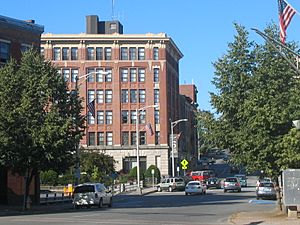Great Fire of 1911 Historic District facts for kids
Quick facts for kids |
|
|
Great Fire of 1911 Historic District
|
|

Bangor Public Library Dome
|
|
| Location | Harlow, Center, Park, State, York, and Central Streets Bangor, Maine |
|---|---|
| Area | 24 acres (9.7 ha) |
| Built | 1911 |
| Architect | multiple |
| Architectural style | Late 19th And Early 20th Century American Movements, Renaissance |
| NRHP reference No. | 84001479 |
| Added to NRHP | June 14, 1984 |
The Great Fire of 1911 Historic District is in downtown Bangor, Maine. It was added to the National Register of Historic Places in 1984. This district protects many important public and business buildings from the early 1900s. It reminds us of how Bangor rebuilt itself after a huge fire. Only Portland, Maine, had a similar rebuilding effort after its own big fire in 1866. The Great Fire of 1911 was one of the last huge city fires in the U.S. It led to the creation of a special city area from the early 20th century. This area is quite unique in Maine and northern New England.
| Top - 0-9 A B C D E F G H I J K L M N O P Q R S T U V W X Y Z |
What Happened in the Great Fire of 1911?
The Great Fire of 1911 destroyed half of Bangor's business center. This included many important buildings. After the fire, people quickly started to rebuild. Most of the buildings you see in the district today were built between 1911 and 1915.
The district has 48 buildings and three parks. Almost all the new buildings were made of brick. Some even had steel frames. A few were covered in terra-cotta or granite. The brickwork shows many different colors and patterns.
Architectural Styles and Designers
The new buildings showed off many different architectural styles. The main style was Renaissance Revival. This style looks back to old Roman and Greek designs. You can also see parts of:
- Romanesque Revival
- Chicago School
- Prairie Style
- Art Deco
- Classical Revival
- Colonial Revival
Many famous architects helped design these buildings. Some were from big national firms like Peabody and Stearns and Carrère and Hastings. The U.S. government architect Oscar Wenderoth also designed buildings. Local architects like C. Parker Crowell and Wilfred E. Mansur also played a big part.
Important Buildings in the District
Many buildings in the Great Fire District are very important for their design. Here are some examples:
- Bangor Public Library (1912) by Peabody and Stearns
- Bangor High School (1912), now apartments, also by Peabody and Stearns
- Morse Building (1914–1915), now a University of Maine art gallery
- First National Bank - Bangor Hydro Electric Building (1915)
- Exchange Building (1913)
- Bangor Savings Bank Building (1912) by Carrère and Hastings
- Eastern Trust Building (1912) by C. Parker Crowell
- Graham Building (1911) by Wilfred E. Mansur. This was one of the first and largest buildings built after the fire.
- Stearns Block (1911) and Stetson Block (1911), both by Wilfred E. Mansur
- Bangor Post Office (1914–1915), now City Hall, by Oscar Wenderoth
Some important buildings were built a bit later. The Bangor Telephone Exchange (1931) is a great example of the Art Deco style in Maine. It was designed by Densmore, LeClear, and Robbins. A few buildings even survived the fire. These include the Tarratine Club (1907) and the Nichols Block (1892).
Parks in the District
The district also includes three parks. These green spaces add to the beauty of the area:
- Norumbega Mall (laid out in 1933)
- Kenduskeag Mall (1912), designed by Warren H. Manning. It has a bronze statue of Hannibal Hamlin.
- Pierce Park (1912), which has a bronze statue of river drivers.
Images for kids






